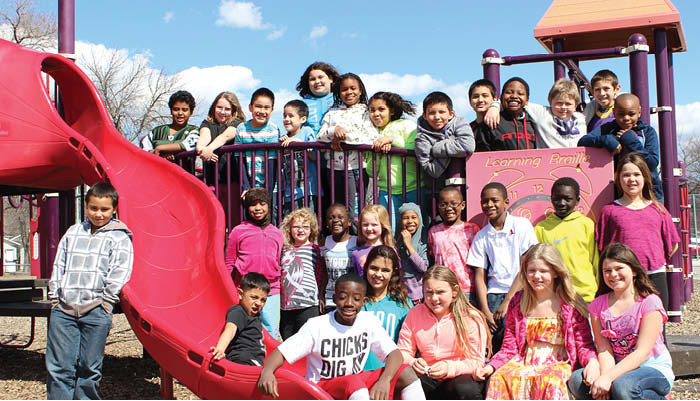Former President John F. Kennedy once said, “A child miseducated is a child lost.” In today’s ultra-technological world, education is power. It is more important than ever to provide the nation’s children with the skills necessary not only to compete, but to succeed. One of the challenges to providing this level of educational excellence is the language barrier that often accompanies a diversified community. The Lutheran Social Service New American program resettles up to 300 refugees in the Red River Valley each year. Many of the children that are either resettled here or born to refugees are often confronted with language barriers between school and home. That reality can make education difficult. For the staff at the Madison Elementary School in Fargo, however, there is no such thing as a barrier to education. They operate under the mantra, “Many nations, one community.” Children at Madison are given the same opportunity to succeed, regardless of race or nationality.
Within the 178 young people currently enrolled at Madison, 12 different languages are spoken. For some that would appear to be a huge challenge; but to the staff at Madison, it is an opportunity. The various cultures represented by the student body are embraced and celebrated, which ultimately leads to feelings of acceptance and inclusion. A flag for each country present in the school line the main office and a sign in the entryway proclaims, “Don’t Blend In – Be Yourself.” That is exactly the message that is portrayed to the student body. “Everyone is mindful of the different cultures,” explained ELL (English Language Learners) teacher Peggy Tri. “It isn’t just one or two people; it is everyone.” The small numbers at the Kindergarten through 5th grade school allow the staff to get to know all of the children and take ownership in their success. “The entire staff embraces the students,” Tri said. “We have their backs.”
The language barriers present in families where the children speak English but the parents do not does present some challenges. Madison has an extensive mentorship program, including volunteers from area schools and businesses. In addition, the ELL program is designed to assist students in developing an understanding that extends beyond social interactions and into the realm of academics. Madison also has an after-school academic tutoring program from 3:00 – 4:00pm that is utilized by virtually half the school. The result of all of these efforts is a communal approach to learning. Students are encouraged to celebrate their distinctive heritages, appreciate each other’s differences, and ultimately develop a base of knowledge that will lead to future success.
Madison’s math scores are consistently in the top half of those throughout Fargo elementary schools. Reading, however, has historically been a struggle. That is changing now, thanks to a concerted school-wide focus in that area. “Reading is key for future success,” explained Madison Principal Bobby Olson. “We have to give them that ability.” Every student who is not a proficient reader or performing at his/her grade level is given an individualized intervention plan. This student-specific attention has made a big difference in the progression of reading abilities across the school. “Our reading is on the rise,” Olson said. “That’s been very exciting.”
Another contributing factor in student improvement has been Madison’s “Read to Lead” program. Noel and Judy Fedje brought the program idea to the FM Area Foundation five years ago, along with the funding to make the program happen. Read to Lead encourages reading by rewarding students for meeting monthly reading goals. Those who successfully meet their goals are recognized monthly at a school-wide assembly. In addition, qualified students are able to go on bi-monthly trips, such as to the Fargo Theatre or the Chahinkapa Zoo. When the program first began, about 40% of the students met their monthly goals. Recent totals have consistently been over 90%. The increased focus on reading and the pride that goes along with success has driven students to reading levels that are surpassing expectations. Success is contagious and it is that kind of contagion that creates a positive learning environment like the one students experience at Madison.
Another reason Madison Elementary is such a special educational environment is the community support it receives. “This truly is a neighborhood school,” Olson explained. “In many ways we are the heart of the neighborhood.” Whether it is high attendance rates at school events or simply supporting their children, the community has embraced the school. The staff at Madison realizes how special that kind of support is. Community service is a big part of the school curriculum. “We get a lot so we need to give,” Olson said. It is often been said that it takes a village to raise a child. The Madison School community understands and embraces this concept. There is no separation between school and neighborhood. Everyone works together for the good of the children.
It is obvious to anyone that walks into Madison Elementary School that there is a level of pride that is palpable. The students and staff mutually respect each other and work together to accomplish common goals. The different cultures that are represented give children a greater appreciation and respect of their differences. “The kids are very accepting of each other as they are,” Olson explained. Friendships at Madison see no color and cross culture lines without regard. Hopefully, these children will grow into the kind of adults that can create a world that sees no color, only people.
William Butler Yeats wrote, “Education is not the filling of a pail, but the lighting of a fire.” That staff at Madison understand that and light small fires each and every day. Despite their differences, the school truly is “Many nations, one community.” Here’s to those fires burning as bright as possible long after those students move on.



